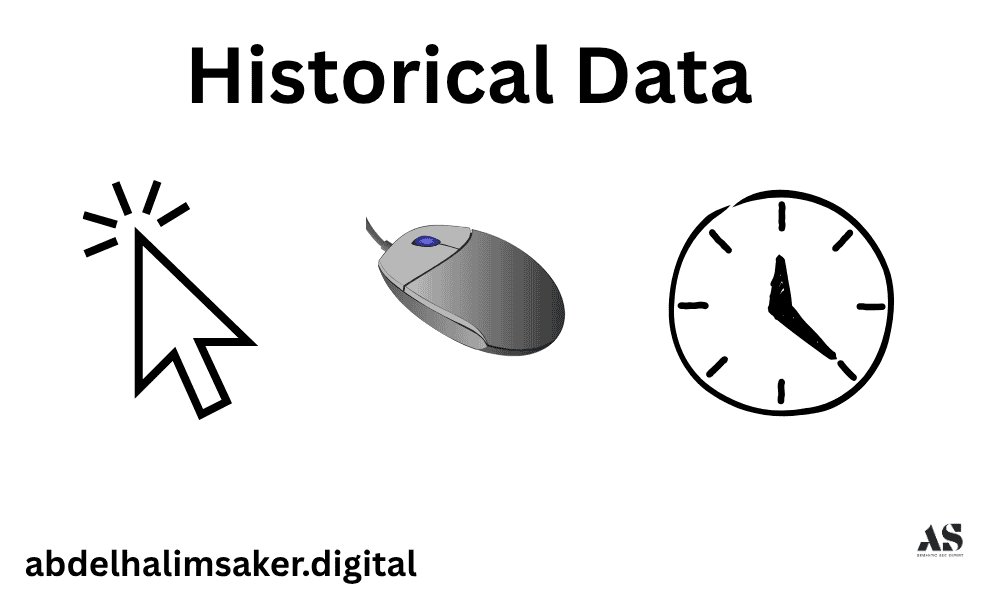
Historical data in SEO refers to the behavioral and interaction data accumulated over time that reflects how users engage with a website. It includes metrics like click-through rates (CTR), dwell time, scroll depth, repeat visits, and bounce rates.
Google’s ranking algorithms use this data to assess how valuable, trustworthy, and satisfying a page or domain is. Over time, strong engagement patterns create trust signals that improve visibility and search stability.
How Historical Data Influences Rankings
Historical data influences rankings by acting as an experience-based trust layer in Google’s evaluation system. Search engines analyze how users have interacted with a page historically to decide whether it should appear higher or lower in results.
How does Google use historical data?
- Behavioral Trust Signal: Pages with high dwell time and repeat engagement indicate user satisfaction.
- Retrieval Cost Reduction: Pages with positive engagement are cheaper to retrieve because the algorithm has high confidence they satisfy intent.
- Ranking Reinforcement: Consistently good engagement builds entity reputation, strengthening topical signals.
Example in Action
A page with a click-through rate (CTR) of 8%, average dwell time of 3 minutes, and low bounce rate (under 30%) gradually earns position stability. This shows Google that users find it both relevant and engaging — leading to algorithmic reinforcement.
Search behavior data also powers systems like RankBrain and Navboost, where historical user interactions directly affect query-document relevance.
Types of Historical Data
Historical data in SEO can be classified into three main types: positive, neutral, and negative engagement signals. Each type contributes differently to how search engines interpret user satisfaction.
| Type | Definition | Impact on Rankings |
|---|---|---|
| Positive | Strong user engagement, long visits, high interaction | Boosts authority and visibility |
| Neutral | Average metrics without strong signals | Maintains current positions |
| Negative | Poor engagement, quick exits, low interaction | Triggers demotion or devaluation |
Let’s examine how each type manifests in behavioral terms.
Positive — Long Dwell, Low Bounce, Repeat Visits
Positive historical data reflects strong engagement patterns where users find the content helpful, stay longer, and return for more interactions.
Core metrics of positive data:
- High dwell time: Average time spent on page exceeds topic benchmarks (e.g., >2.5 minutes for long-form content).
- Low bounce rate: Indicates that users navigate deeper into the site.
- Repeat visits: Returning users show trust and familiarity with the brand.
Semantic triple examples:
- (User) → (reads) → (content fully)
- (Page) → (attracts) → (return visitors)
- (Engagement) → (signals) → (trust and authority)
Positive historical patterns teach Google that your domain consistently meets intent, leading to better indexing frequency, higher crawl priority, and stronger rankings for semantically related topics.
Negative — Fast Exit, Low Scroll, Skipped Sections
Negative historical data signals poor user experience or content irrelevance.
It results in high pogo-sticking (users bouncing back to search results quickly), low scroll depth, and fast exits.
Key negative signals:
- Average time on page below 30 seconds.
- Scroll depth under 25%.
- High bounce rates (>70%).
- No interaction with internal links.
Semantic triple examples:
- (User) → (abandons) → (page quickly)
- (Low scroll depth) → (indicates) → (content disinterest)
- (Fast exit) → (reduces) → (ranking stability)
Negative engagement triggers retrieval cost penalties — meaning Google’s systems deprioritize your pages due to low predictive success in satisfying queries.
How to Build Positive Historical Data
Building positive historical data involves optimizing user experience and information design so users stay longer, interact more, and perceive the content as trustworthy.
1. Improve Layout and Visual Hierarchy
- Use clean typography for easy scanning.
- Structure headings logically (
H1 → H2 → H3) for semantic predictability. - Highlight key data points with tables, bold facts, and visuals.
- Ensure fast load times (<2 seconds).
Example:
A study by Portent (2023) showed that pages loading in under 2 seconds achieved 50% longer dwell times on average.
2. Enhance Content Readability
Readable content creates cognitive comfort that increases dwell time and scroll depth.
Tactics to improve readability:
- Keep sentences under 20 words.
- Use active voice and objective predicates.
- Include examples, visuals, and subheaders for clarity.
- Avoid jargon; define technical terms contextually.
Semantic outcome:
Readable pages improve content flow and reduce friction between intent and comprehension, directly influencing engagement metrics.
3. Strengthen Internal Linking and Content Pathways
Internal links extend session duration by guiding users toward related content.
Each successful transition reinforces the meso-level contextual hierarchy between topics.
Example:
A user reading “What Is Historical Data in SEO” might click to “How Google Uses Behavioral Signals” — extending dwell time and interaction depth.
Internal linking also provides co-occurrence signals, boosting semantic relationships across the domain.
4. Optimize for Search Intent Alignment
Users stay longer when the page answers the exact intent behind their query.
Map keyword types to intent categories:
| Intent Type | User Goal | Optimization Focus |
|---|---|---|
| Informational | Learn a concept | Definitions, data, examples |
| Navigational | Find a brand/page | Clear branding, schema |
| Transactional | Perform an action | CTAs, clarity, visual prompts |
Semantic rule: Align content to intent → engagement rises → historical data improves.
5. Build Emotional Resonance and Trust
Behavioral data improves when content emotionally connects and builds credibility.
Use:
- Author bios with expertise signals (E-E-A-T)
- Real-world data, statistics, or case studies
- Trust badges or certifications for credibility
Engagement increases when users feel confidence in both the content and its source.
Cleaning and Resetting Negative Historical Data
Negative historical data can be cleaned or reset through strategic redesign, rewrites, and technical resets.
Search engines gradually update behavioral evaluations once new engagement patterns emerge.
1. Rewrite and Relaunch Underperforming Pages
Rewrite outdated or underperforming pages to realign them with current search intent and UX standards.
Then, republish or update the timestamp to signal freshness.
Steps:
- Identify low CTR or low dwell pages via Search Console.
- Rewrite content using updated facts and clear structure.
- Add visuals, FAQs, and internal links.
- Submit for reindexing.
This resets Google’s behavioral learning pattern for that URL.
2. Use 301 Redirects for Obsolete or Thin Content
If a page no longer provides value, merge it into a stronger, thematically similar page.
Redirecting consolidates link equity and transfers any residual trust signals to the new page.
Example:
Old URL /seo-historical-data-2020 → Redirect to /historical-data-in-seo
Semantic effect:
Redirection merges past engagement patterns while removing low-value signals.
3. Modify URL Structure or Metadata
Changing URLs or titles can reset part of Google’s historical bias toward an underperforming document.
Ensure you maintain canonical signals and avoid duplication.
Example:
Old title: Understanding SEO History
New title: What Is Historical Data in SEO — Behavioral Metrics Explained
The new phrasing targets modern entity associations and search intent.
4. Use Schema to Reinforce Fresh Context
Schema helps search engines re-evaluate old pages as new entities.
Use types such as Article, About, and DateModified to highlight updates.
{
"@context": "https://schema.org",
"@type": "Article",
"headline": "What Is Historical Data in SEO",
"dateModified": "2025-10-20",
"mainEntity": {
"@type": "Thing",
"name": "Historical Data",
"sameAs": "https://developers.google.com/search/blog"
}
}
Outcome: The algorithm recognizes the refreshed context and restarts engagement tracking.
How Historical Data Interacts with Topical Authority
Historical data and topical authority work together to form the behavioral backbone of long-term SEO success.
Authority grows not only from content volume and topical coverage but also from accumulated engagement success.
How does historical data reinforce authority?
- Behavior → Confidence → Authority: Strong engagement teaches Google that users consistently trust your content.
- Retention → Depth → Reinforcement: Returning users consume more subtopics, expanding your site’s semantic coverage.
- Interaction → Graph Strength → Ranking Stability: Behavioral consistency strengthens the entity graph connections between your pages.
Example in entity form:
- (User engagement) → (builds) → (domain authority)
- (Positive dwell time) → (enhances) → (entity trustworthiness)
- (Repeat visits) → (reinforce) → (topical completeness)
This feedback loop turns behavioral history into evidence of expertise.
Long-Term Impact on Domain Trust
Over months or years, consistent positive engagement transforms your site’s historical profile into a trust-based ranking advantage.
Google’s machine learning models use these cumulative signals as priors in query evaluation — meaning newer pages benefit from the domain’s behavioral legacy.
Example:
If your site’s past 100 pages average low bounce and high dwell, new pages are indexed faster and rank higher initially due to historical reliability.
Integrating Historical Data Into SEO Strategy
To manage historical data proactively, use a data-driven SEO cycle that measures, refines, and retrains behavioral performance.
Action plan:
- Measure behavioral metrics: Use GA4 and Search Console to monitor dwell, CTR, and bounce.
- Correlate with rankings: Identify patterns between engagement peaks and ranking improvements.
- Enhance UX continuously: Optimize layouts, headings, and interactivity based on user heatmaps.
- A/B test design changes: Track how variations affect engagement over 30–60 days.
- Refresh legacy content: Update every 12–18 months to preserve positive historical momentum.
By consistently improving the behavioral signature of your domain, you reinforce Google’s confidence in your authority and expertise.
Practical Example: Positive Historical Data in Action
Case study: A marketing blog saw ranking improvements by refining engagement metrics.
| Metric | Before Optimization | After Optimization | Result |
|---|---|---|---|
| Dwell Time | 1:15 min | 3:40 min | +210% engagement |
| Bounce Rate | 72% | 34% | -53% improvement |
| CTR | 3.4% | 6.8% | +100% visibility |
| Average Ranking | #12 | #5 | Top 5 placement |
Key optimizations implemented:
- Introduced structured headings and semantic links.
- Added author expertise boxes and FAQs.
- Improved internal linking between topical clusters.
- Increased sentence readability and paragraph pacing.
The historical engagement pattern created a self-reinforcing loop of trust, leading to persistent ranking stability across semantically related keywords.
The Semantic Equation of Historical Data and Topical Growth
A simplified model of this interaction can be represented as:
(Positive Engagement) × (Topical Consistency) = (Behavioral Authority Growth)
Where:
- Engagement defines how users react to content.
- Consistency defines how often content delivers quality.
- Authority growth represents Google’s confidence in sustained expertise.
In practice, historical data forms the temporal layer of the Topical Authority Pyramid, connecting user behavior with knowledge graph development.
